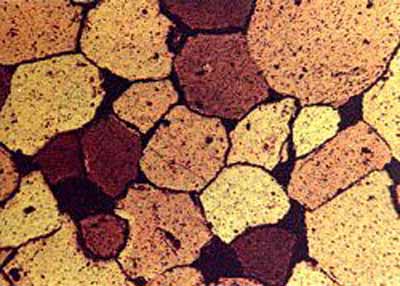|
 |
Above is a photograph through a microscope of actual sandstone, which is a porous rock. The photograph shows the pores between the grains. It is in these pores that the gas migrates or collects. |
We now know that gas does not flow in rivers underground. Over eons, gas occurs in, or migrates upwards through, porous and permeable rocks until it hits a layer of “cap rock” that is not porous or permeable. The gas is “trapped” beneath that cap rock in a pool from which it can be produced.
(At that time natural gas was not considered valuable, and was released or lighted and flared into the atmosphere so that the oil could be produced. Now, gas is the predominant hydrocarbon for which wells are drilled in West Virginia. For the most part, the remainder of this slide show will usually talk about gas wells, but the principles apply to both.)
Note that beginning primarily in 2008, new "fracture" techniques have been developed for use in shale source rock strata where gas was formed. These new techniques are pricipally applied to, and are responsible for, the huge Marcellus Shale "play" taking place. These new techniques overcome the lack of porosity and permeability of these rocks. So the gas can be produced economically directly from this source rock instead of the "sands" to which it migrated over the centuries. In fact gas wells drilled to shales using these tehcniques produce much, much more gas than those drilled to sands. However, for the purposes of this presentation, the relevant facts are still the same. The gas does not run underground in rivers. It is still spread relatively evenly through the rocks. The increased productivity and profitability make it even more advisabe to have forced pooling and unitization.
| Go directly to intro or slide: 1 2 3 4 5 6 7 8 9 10 11 12 13 14 15 16 17 18 19 20 21 22 23 24 24a 25 26 27 28 29 30 31 32 33 |